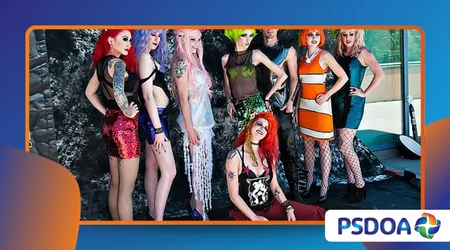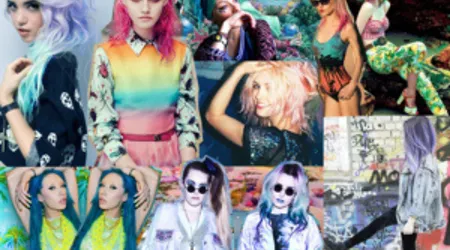Seapunk, Cybergoth, and Other Internet-Born Aesthetics

Seapunk, Cybergoth, and Other Internet-Born Aesthetics represent a profound shift in how youth subcultures are conceived, organized, and disseminated.
Anúncios
No longer confined to specific geographic locales or music scenes, these movements are fluid, visually-driven, and primarily born on platforms like Tumblr, TikTok, and Discord.
This phenomenon confirms that the internet is the ultimate cultural laboratory of the 21st century. This column explores the ephemeral yet impactful nature of these digital microcultures.
We dissect their core visual language and analyze the mechanisms by which they transition from niche online “vibes” to palpable influences on mainstream fashion, music, and marketing strategies.
Understanding this digital genesis is essential for comprehending contemporary culture.
Anúncios
What Defines the Digital Origin of Seapunk and Cybergoth?
The true power of Seapunk, Cybergoth, and Other Internet-Born Aesthetics lies in their creation ex nihilo from an image or a tweet, not a physical gathering.
Seapunk, for instance, famously began in 2011 with a whimsical tweet about a “Seapunk leather jacket with barnacles,” evolving rapidly into a cohesive aesthetic.
The instantaneous global reach of the internet allows a single idea to become a visual framework almost overnight, bypassing traditional gatekeepers.
The Genesis of Seapunk
Seapunk is characterized by a surreal blend of aquatic motifs dolphins, ocean waves, and neon greens/blues mixed with 1990s web iconography, 3D net art, and a nostalgic, slightly glitchy visual style.
Its early momentum was entirely visual, fueled by Tumblr users creating and sharing digital collages rather than attending real-world events.
The aesthetic quickly birthed its own electronic music microgenre, incorporating ’90s house, R&B, and Southern trap elements overlaid with a “twinkly, narcotic energy.”
This simultaneous development of visual and auditory codes, all facilitated by digital sharing, is a hallmark of internet-born cultures.
++ The Bizarre World of Competitive Yo-Yo Subculture
The Evolution of Cybergoth
While Cybergoth has deeper roots, stemming from the late 1990s as an offshoot of the Goth subculture, its modern visibility and evolution are entirely internet-dependent.
It fuses elements of industrial and EBM music with a distinctive aesthetic of synthetic dreads, massive goggles, neon accents, and cybernetic accessories.
Today, platforms like Instagram and TikTok are critical for sharing tutorials, fashion styling, and community building, transforming a once localized club culture into a globally accessible performance.
The internet acts as both the stage and the archive for this aesthetic’s continuous evolution.

How Do Microcultures Rapidly Influence Mainstream Trends?
The speed and viral efficiency of Seapunk, Cybergoth, and Other Internet-Born Aesthetics mean their influence on mainstream culture is often felt within months, not years.
These microcultures function as rapid-fire trend accelerators, feeding ideas to the fashion and music industries almost instantaneously.
Also read: Vaporwave Architecture: When Design Meets Anti-Capitalism
The Ripple Effect in Fashion
The distinct color palettes and motifs of digital aesthetics frequently leap into high fashion and fast fashion.
Seapunk’s neon teal and lilac hues, along with its 3D digital art influences, were quickly adopted by major artists like Rihanna and Azealia Banks in 2012, pushing the palette into global consciousness.
This process involves a cultural transfer: an aesthetic starts as niche, gains visibility through social media, and is then decontextualized by major brands for mass appeal.
The constant search for novelty means brands perpetually monitor these niche online communities for fresh inspiration.
Read more: From Underground to Mainstream: The Lifecycle of Subcultures
The Impact on Music Production
Digital aesthetics are intrinsically linked to new musical genres like Vaporwave and Hyperpop, which started as online mood boards but quickly became defining sounds of their respective eras.
Hyperpop, with its glitchy, high-energy, and genre-blending sound, evolved from a niche internet scene to a powerful influence on modern club music by 2025.
According to a 2025 report on music trends, the fusion of Hyperpop elements with Techno and Synthwave is a key driver in current music production, a clear testament to an aesthetic that originated entirely online.
This shows how digital subcultures often create the very soundtrack of our present moment.
Why Are Microcultures Replacing Traditional Subcultures?
Traditional subcultures, defined by geography and specific gathering places (e.g., punk clubs), relied on scarcity and physical presence.
Seapunk, Cybergoth, and Other Internet-Born Aesthetics thrive on abundance, democratizing participation and fragmenting culture into personalized “cores” or “vibes.”
The Rise of the ‘Aesthetic’ Identity
The focus has shifted from adhering to a rigid subculture’s ideology to embracing a flexible ‘aesthetic’ identity.
An aesthetic offers a temporary, customizable persona, allowing individuals to quickly shift between Dark Academia, Cottagecore, or Cyberpunk without permanent commitment.
This fluidity reflects the priorities of Generation Z, which values authenticity and self-expression through highly visual means.
As one major trend report noted, “Subcultures aren’t dead, they’re evolving,” moving into the digital “third spaces” of platforms like Reddit and TikTok.
The Role of Technology in Fragmentation
The algorithm-driven nature of modern social media platforms encourages the fragmentation of culture into smaller, highly personalized groups.
Since platforms reward niche content, creators naturally gravitate toward hyper-specific aesthetics, like “Solar Punk” or “Weirdcore.”
This process is like shining a laser beam through a prism: the light is broken down into countless unique colors.
Each microculture represents a specific wavelength of identity, easily discoverable by others through hashtags and algorithmic suggestions, fostering small but deeply passionate communities.
| Internet Aesthetic | Primary Visual Elements | Key Mainstream Influence | Platform Origin |
| Seapunk | Neon Teal/Lilac, 3D Dolphins, ’90s Glitch Art | Mainstream Pop Music Videos (2012-2014), Fashion Color Palettes | Tumblr, Twitter |
| Vaporwave | Greco-Roman Statues, Low-Fidelity Graphics, Saturated VHS Effects | Retro Web Design (2025 Trend), Lo-Fi Music Genre | 4chan, Tumblr |
| Cybergoth | Neon Dreadlocks, Goggles, Industrial/Cybernetic Accessories | Techwear Fashion, EDM and Industrial Music Scene | Early Forums, Modern TikTok |
| Cottagecore | Rustic Living, Soft Textures, Pastoral Imagery | DIY Trends, Mainstream Homeware/Interior Design | Tumblr, TikTok |
Source: Based on analysis of cultural trends, Wikipedia, and social media data (2025).
The digital landscape is a crucible where Seapunk, Cybergoth, and Other Internet-Born Aesthetics are forged, tested, and sometimes amplified into global trends.
These microcultures, driven by the visual, accessible nature of social media, offer a powerful lens into the future of self-identity and cultural production.
They prove that a small, dedicated online community can exert more cultural influence than a vast, disorganized physical movement.
The question for brands and artists is not if these aesthetics will influence them, but how fast they can adapt to the next visual revolution. Share your favorite internet aesthetic in the comments below!
Frequently Asked Questions
What is the biggest difference between a subculture and an aesthetic?
A subculture typically requires ideological commitment, specific music consumption, and physical gathering.
An aesthetic is primarily visual, flexible, and often involves temporary digital adoption, focusing more on mood (“vibe”) than rules.
Can an aesthetic become a subculture?
Yes, an aesthetic can deepen into a subculture when a dedicated music scene, strong philosophical underpinnings, and consistent offline community engagement develop, though most remain fluid.
How does the rise of AI affect the creation of new aesthetics?
AI accelerates the creation of new aesthetics by providing powerful, accessible tools (like Midjourney) that allow users to generate and iterate complex visual styles instantly, leading to an even faster turnover of microcultures.
How long do internet aesthetics typically last before being replaced?
The lifespan varies greatly, but the speed of turnover has increased. Many micro-aesthetics last only 6 to 18 months before being eclipsed or absorbed by the next viral trend, requiring continuous cultural monitoring.
